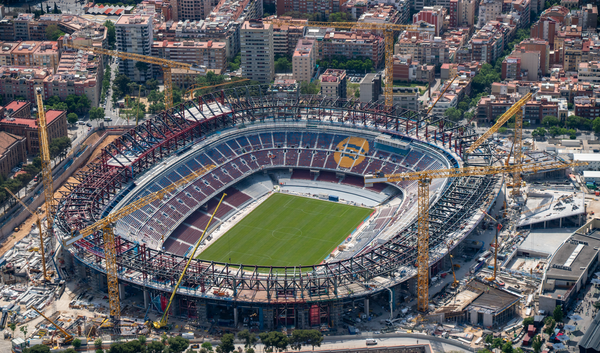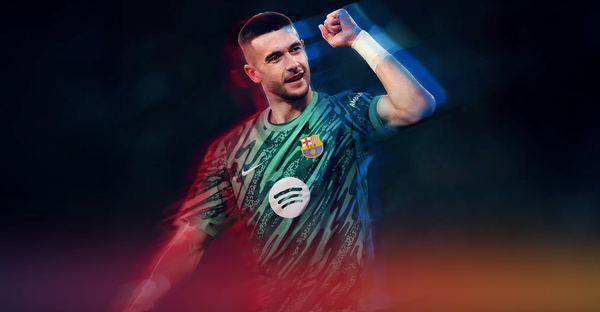Gavi 2.0: From Xavi's utility player to a Barcelona superstar
Gavi is on his way to stardom. Here's his full scout report.
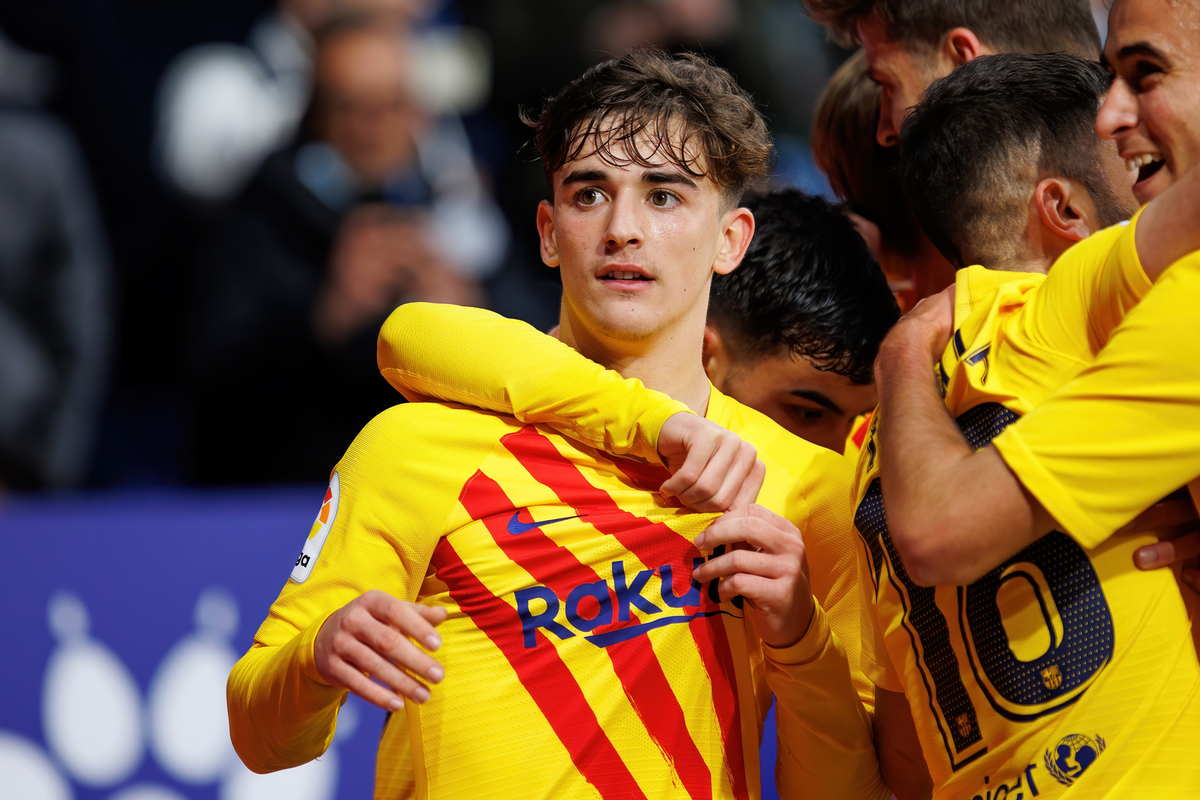
Gavi is somewhat of a controversial figure in the world of football. To some, the Golden Boy is just that; a tremendously talented LaMasia gem whose future in the sport is brighter than most. To others, he is just passion, running and arrogance. What many fail to understand, however, is that Gavi is both of those things; he is certainly confident, loud and brave, even arrogant to a certain extent. But he is also supremely talented. Unbelievably so.
So who is this 19-year-old kid taking Barcelona by storm in 2023/24?
Gavi 22/23 vs Gavi 23/24
It's pretty interesting how roles and profiles interact with one another. A certain player of a certain profile will flourish in a certain role. But that same player might look heartbreakingly out of sorts in a different one. It's funny how football works that way and there have been numerous examples at Barcelona alone in the past few seasons where players' whole careers were shattered just because they were never optimally used.
Gavi's case is not as extreme; he's a midfielder who's been deployed in a rather unflattering role throughout most of Xavi's tenure as the Catalans' coach. But he's also done decently well, especially considering the requirements of that infamous left-winger function.
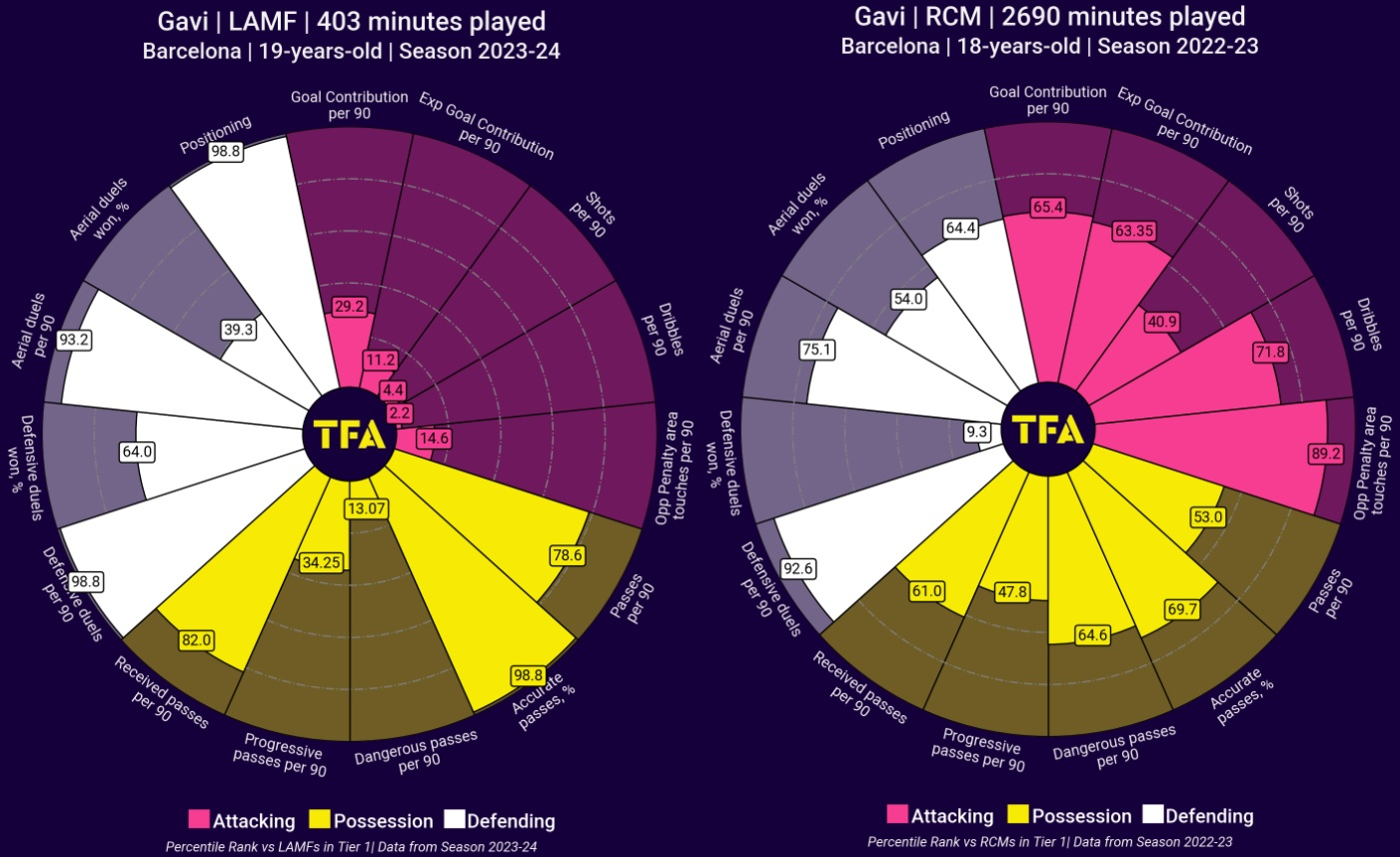
Above, we see a comparison between Gavi's current 2023/24 season and his 2022/23 season. Naturally, the difference in the sample is massive; 23/24 is just starting and we're only a couple of games in. However, we can already see some differences shaping up. For instance, with his move to a much deeper interior position, Gavi is now more involved on the ball and is contributing to the team's tempo through his recycling and retaining abilities.
Defensively, of course, he's still very much an intense presser and a willing worker. That hasn't changed and will most likely not change at all. Offensively, however, we may be looking at a slightly different player altogether. As that left-winger, Gavi would often find himself inside the box or just around it, looking to make runs, receive in the dangerous zones and convert. With a deeper controller role, that might change.
However, Gavi also has incredible attacking instincts which are best visible in the goals he scores and the way he moves. All of this makes him a prototype box-to-box player.
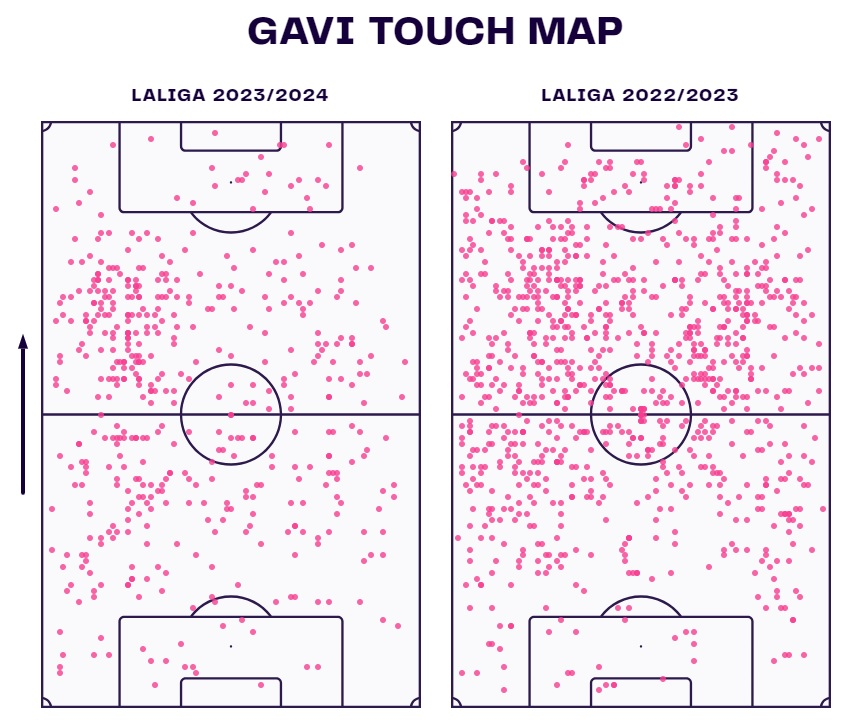
Similarly to last season, Gavi is everywhere; he's the type of player who can influence all phases of play. However, even with a much smaller sample to work with, we can already see some clusters forming. The left half-space, both in the opposition's half and deeper, are our points of interest. This is where Gavi's contribution is at its peak. Naturally, he still ventures higher up, even up to the penalty area, but is much more focused on constructing the play.
This change has unlocked a new version of the same player; a version that focuses on his technical excellence, understanding and athleticism rather than relegating him to a supportive utility player. So what exactly does this new Gavi offer Xavi and his squad?
Gavi the controller
So far, we have seen Gavi in two distinct roles this season: a high interior role and a deep controller role. The former emulates Pedri while the latter is more in the Frenkie de Jong mould. Naturally, Gavi gives both roles his own distinct twist and makes them unique. But when it comes down to it, he's providing Xavi with a flavour of the two aforementioned players. He's far from a like-for-like replacement, of course, but has the ability to replace either of them.
The deeper role, in particular, is something that's come to light recently. With that left-winger scenario in 2022/23, we rarely saw Gavi in the deeper areas controlling the game; instead, he'd often be an outlet, a body to occupy or dismark and a player whose general involvement in positional play was decreasing. Now, however, we see the exact opposite.
Interestingly, I discussed the midfield balance Xavi is trying to achieve in one of my previous pieces on the site which you can read on the link above. Essentially, the arrival of both Joaos has enabled Barcelona to create a steady midfield without necessarily cutting off one of their players in the box. As such, Gavi's involvement seems to be on the rise, as confirmed by the number of touches he's had this season.
Since the beginning of 2023/24, he's been getting more and more involved, culminating with his season-high of 72 against Antwerp and 71 against Celta Vigo. In both of those games, he assumed a deeper controller role, slotting alongside De Jong in the former and outright replacing him in the latter. And in both cases, he was superb. So what makes him such a great fit for a deep controller role?
Gavi isn't necessarily an elite progressor of the ball like De Jong. If we look at his passing maps, we'll see he tends to recycle possession and is often risk-averse in his passing.
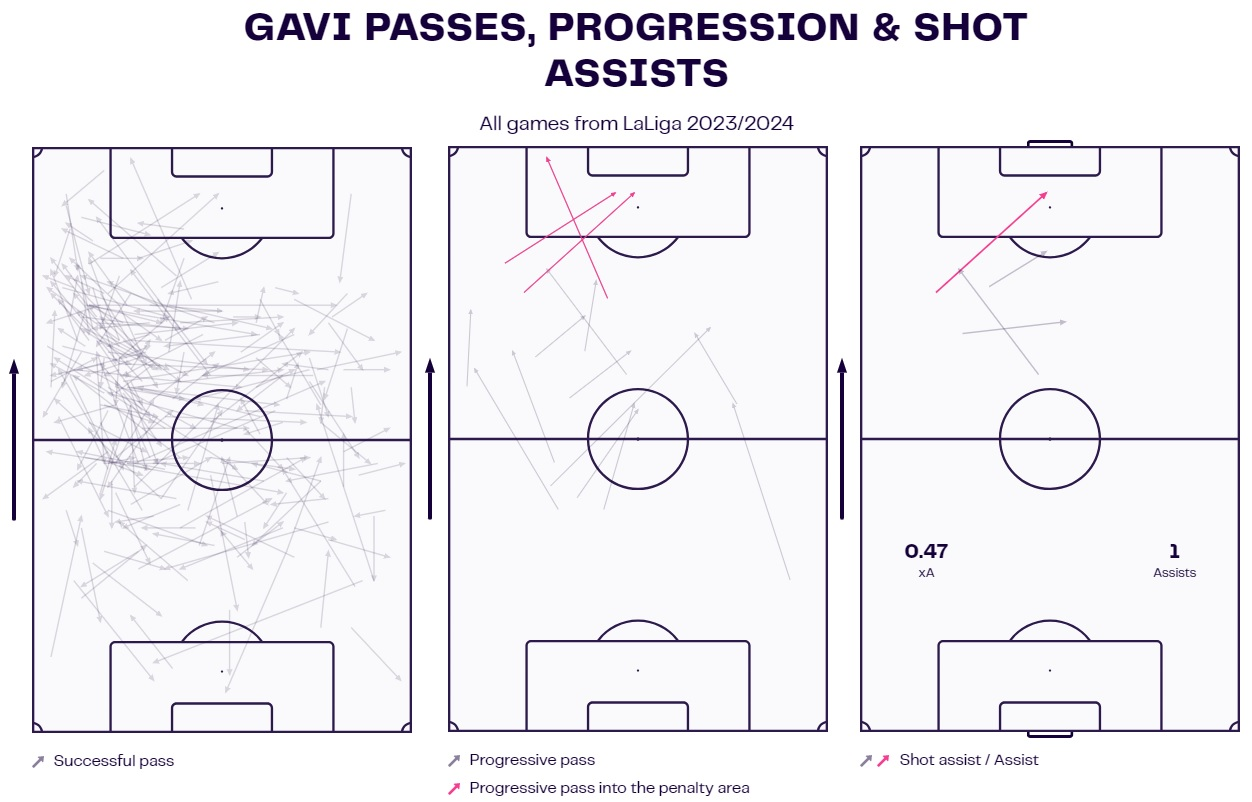
If he does progress via his passing, it usually happens around the centre of the pitch and involves a short line-breaking pass, a switch or a shuttle out wide. None of these are often flashy but they are effective. Gavi is a player who won't force verticality for the sake of it and that makes him an excellent player to set the tempo and control the game.
In that sense, it's not so much a case of him not being able to be the creative hub of the team or a risk-taker in possession but choosing not to be. There have been scenarios in the last couple of games where Gavi could've played the ball forward and increased the tempo but opted against it, choosing control over chaos.
This is an invaluable trait for a possession-heavy team like Barcelona and a player in a deep role such as this one.
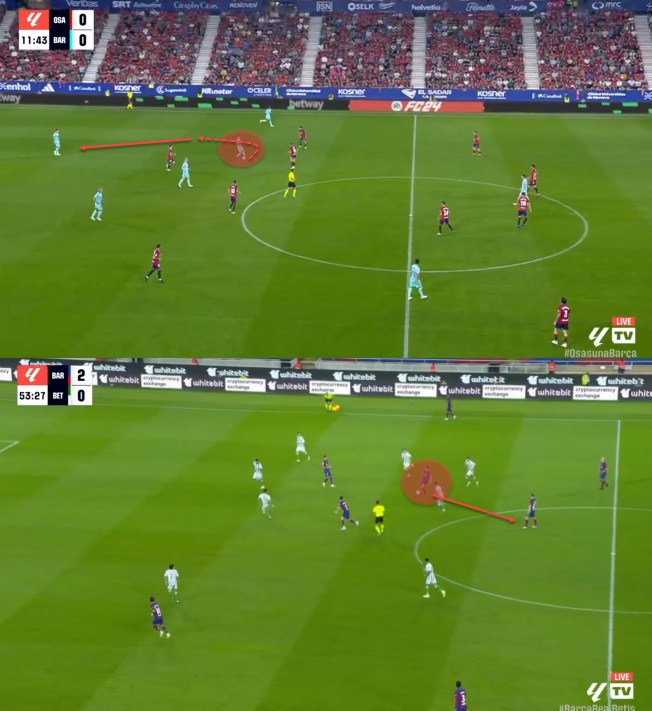
Take these two sequences as great examples of that. Instead of pushing forward and trying to force verticality when the options are either too risky or even non-existent, Gavi opts to recycle possession and wait for a better opening. Against Real Betis in the second image, in particular, there was a clear avenue to attack but Gavi decides Barcelona should not rush because there is no need for it. So the ball goes back to De Jong instead.
In the first image in the sequence against Osasuna, Gavi sees his passing lanes are all blocked so instead of forcing his way through, he stops, turns back and invites Osasuna to step out of their defensive block. Most see this and think it's a bad thing but in reality, this is how negative passing (passing that doesn't progress play) helps you ultimately move forward.
And Gavi is very good at problem-solving like that. Take these next sequences, for example.
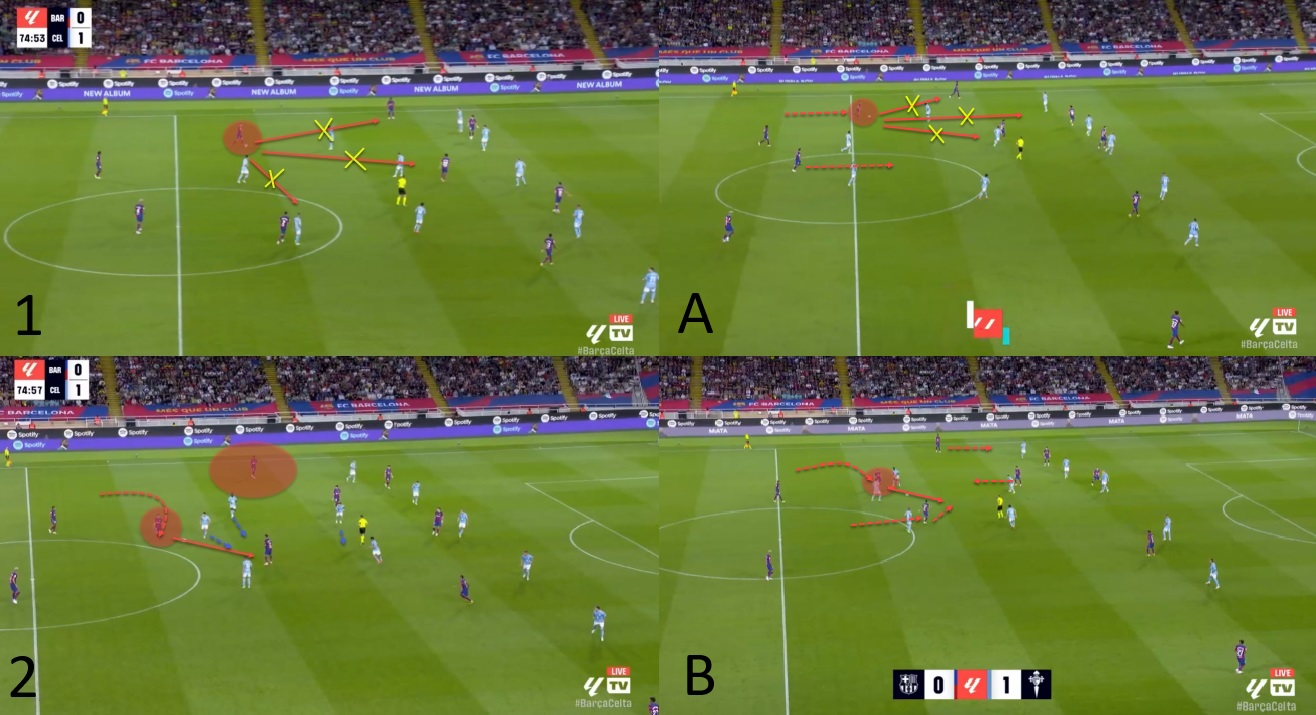
In both instances, Gavi is facing a problem where he doesn't have a clear passing lane to exploit. In such scenarios, he can either recycle until a gap appears, force verticality or problem-solve. Two out of those three options are acceptable in these scenarios and he goes for the third one - problem-solving. And incidentally, this is also where we can see flashes of De Jong in Gavi as well; they are both excellent carriers of the ball and prefer to progress in that manner.
In fact, with 3.45 progressive runs per 90 minutes, only Alejandro Balde and Frenkie himself have more in Barcelona's team. Similarly, he's the squad's third-best midfielder in dribbling capacity, registering 1.34 per 90 minutes. These two things combined make him an excellent tool to both disorganise the opposition's defensive unit and progress play, albeit not by traditional means. And it's how in both of the examples above he creates a passing lane where previously there was none.
Gavi likes to run with the ball just like Frenkie does and that forces the opposition to abandon their positions and collapse onto him. However, it also creates space elsewhere and Gavi himself manufactures passing channels through his movement. In both examples, he finds a way to pass the ball safely even though at first that seemed impossible. Interestingly, this also works both ways.
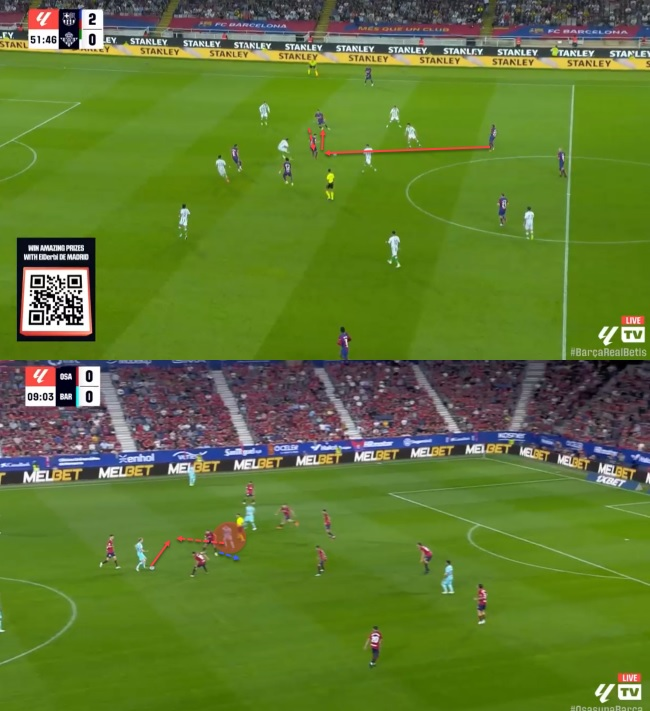
He can create passing lanes by moving with the ball but also without it as well. If he's the one expecting or wanting a pass, Gavi knows how to reposition smartly to create those passing channels and make it easier for the ball carrier to access him. In the above examples, Gavi uses the defender's blindside to give his teammate a safe passing option.
But the 19-year-old is also very adept at using his frame to his advantage. This is usually done in two ways: he will either use his body to shield the ball and turn with it or he'll use his agility to receive on the half-turn and immediately progress play. Either way, he uses his body as a press-resistance tool that's invaluable in both the deeper and higher areas of the pitch.
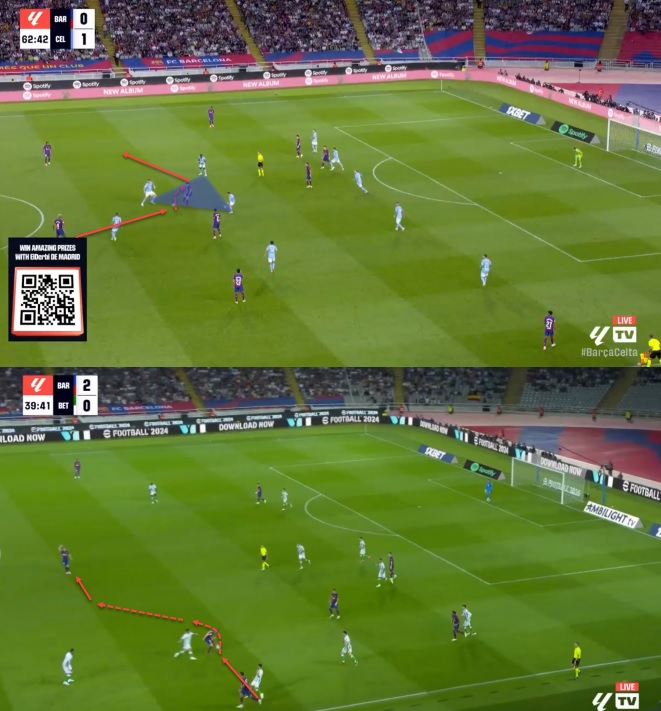
Interestingly, using his frame and duelling are things that make him such a unique presence in Barcelona's entire squad. Yes, it makes him very press-resistant but it also gives Xavi more control in midfield. Technical excellence is what most usually associate with controlling the game and dominating the opposition with the ball but an athletic physical presence is another fundamental way of getting the same result.
Gavi is the type of player who can shield the ball, retain possession through intense duelling and use his frame to avoid potential recoveries from the opposition. This, paired with his incredible technical floor, creates the press-resistant profile he has. In fact, Gavi has the most duels per 90 minutes in the whole squad (27.63) and the fifth-most offensive duels per 90 (6.72), only behind De Jong when compared to just midfielders.
I'll touch upon his passing repertoire a bit later in the analysis but that too makes for a very important part of his deep controller role.
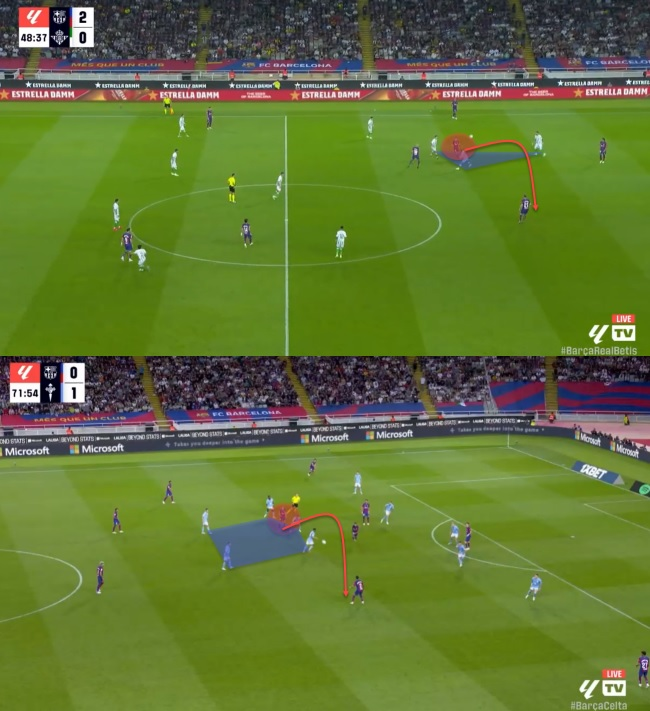
Gavi is comfortable receiving in tight spaces and then either outmanoeuvring the opposition or simply passing the ball out of danger. Above, you can see the signature dink over the congested area and into the feet of a free teammate nearby.
Gavi the interior
When it comes to the more attacking side of Gavi, opinions differ; many believe he's not a good-enough creative force while others claim the opposite. The numbers confirm his output is still not at an elite level, far from it. However, the platform for him to be an output player was never really there. During his left-winger days, he spent a lot of time in the opposition's box, sure, but the angles for his deliveries were different and he was mostly a decoy or a utility player to release and dismark other forwards.
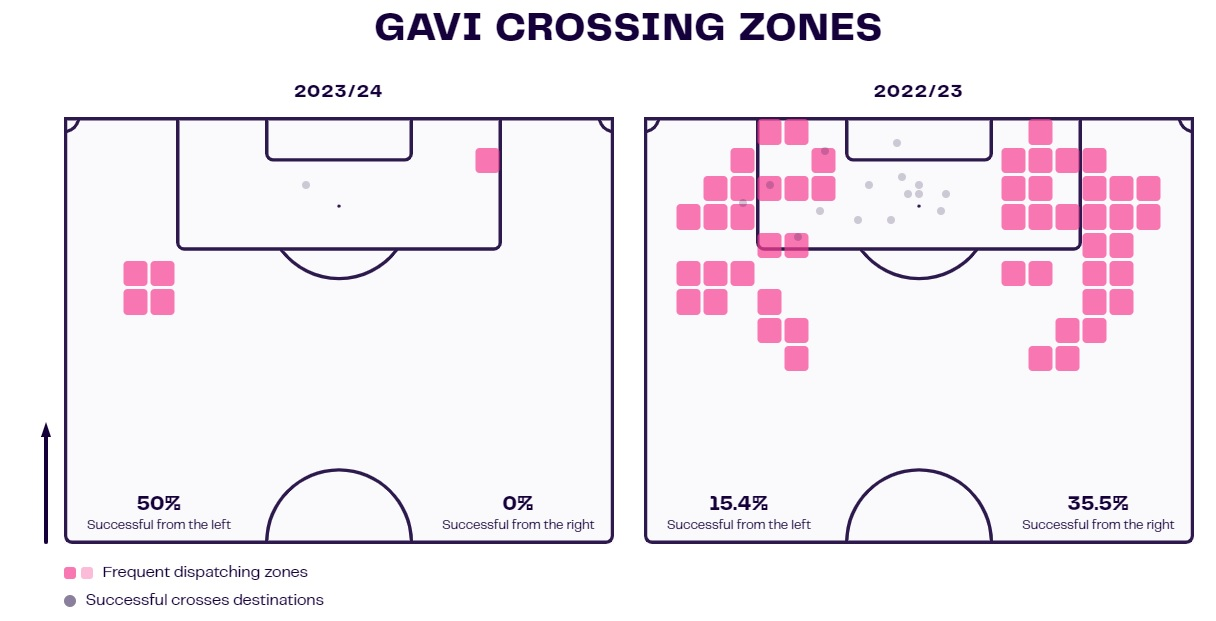
Above are Gavi's crossing zones with a caveat of a big discrepancy in the sample size. However, what we can discern here is that Gavi's deeper role has him deploy passes from a slightly different and more specific area in the left half-space. This is important because of the angle of the delivery and how Gavi is positioned when attempting such crosses.
His assist to Joao Cancelo's winning goal against Celta Vigo came from that very spot and it is no coincidence. Even if we look at his previous attempts to cross into the penalty area this season, they all originate roughly from that very same spot. Meaning that Gavi has been trying that very same pass over and over again until he finally succeeded.
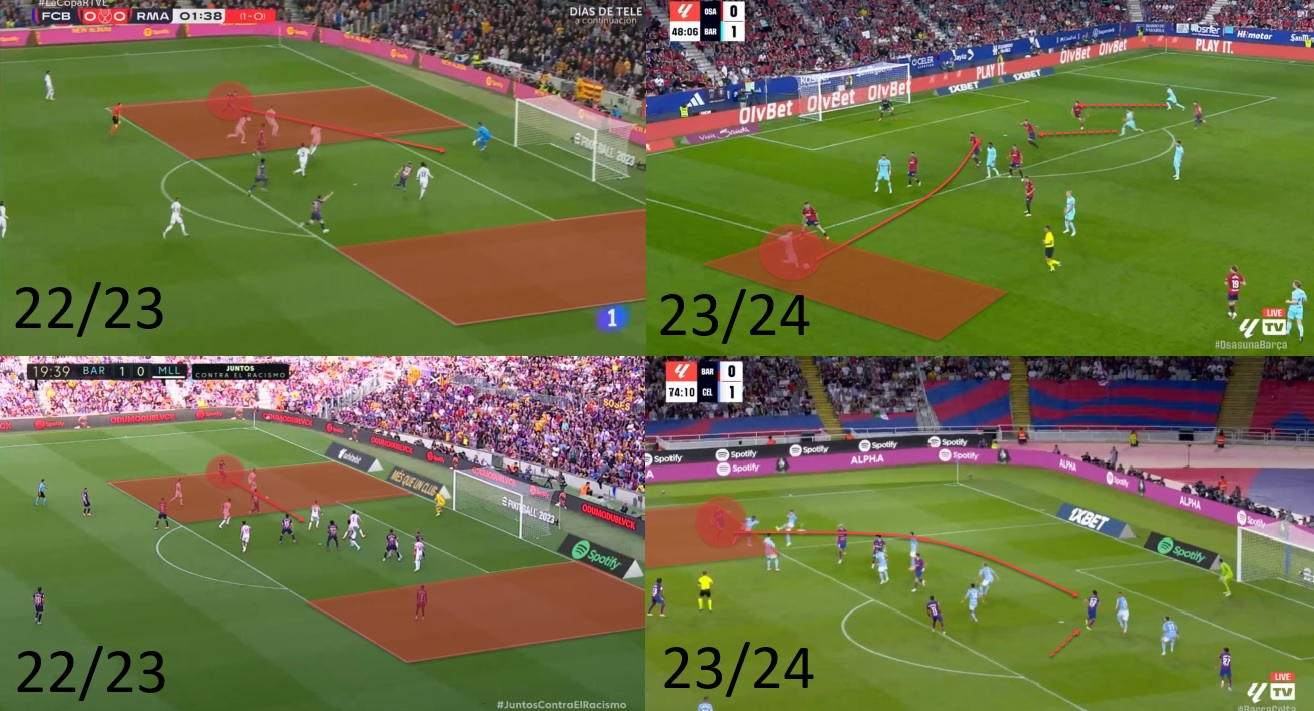
This is a comparison between those delivery zones this season and the previous one. Last season, Gavi was forced too high and as a result, he had to rely on cutbacks into the box with his left foot and from a very wide angle. This season, however, he's deploying them from a much deeper area and can open his body for a right-footed delivery into the runners Barcelona have on the other side of the pitch.
The examples above are almost identical to his assist to Cancelo but are, in fact, different sequences altogether. This tells us the assist - or the zone from which it was deployed - was not a coincidence or a one-off occurrence; they've been made on the training pitch. And considering Gavi's excellent technical foundation and the quality of his passing repertoire, it is possible and even expected that his output should rise should he continue to be deployed in this manner.
But while passing is certainly a strength of his, carrying is still his weapon of choice. We've already established he's among the team's best carriers, only behind De Jong and Balde, and this tool is used for both progression and creation.
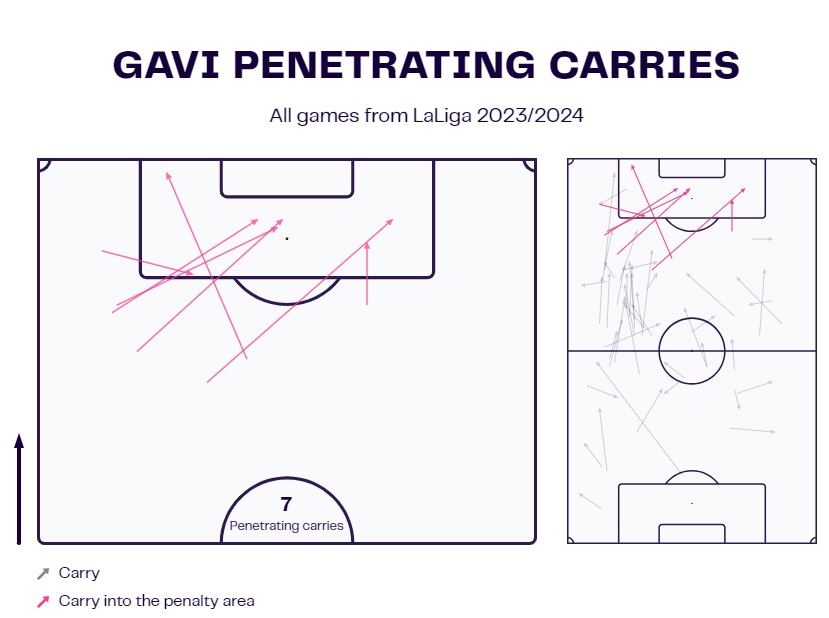
When we compare these graphs to his progression via passing, it becomes evident which one he prefers. Carries and subsequently dribbles are Gavi's way to bypass the heavy marking and gain territory for Barcelona. This trait is invaluable and it's also what makes someone like De Jong the superstar elite he is in world football.
Gavi isn't necessarily an elite dribbler but he can create space for others and himself. The runs we see above are long carries that penetrate the box and are subsequently creation and progression tools, as alluded to earlier in the analysis. But what Gavi does on the ball is not the only way for him to affect the game or create.
In fact, under Xavi, one of Barcelona's main ways to create chances is through their high pressing. Recoveries near the opposition's box often turn into dangerous situations and scoring opportunities, not least thanks to Gavi's intense duelling and pressing.
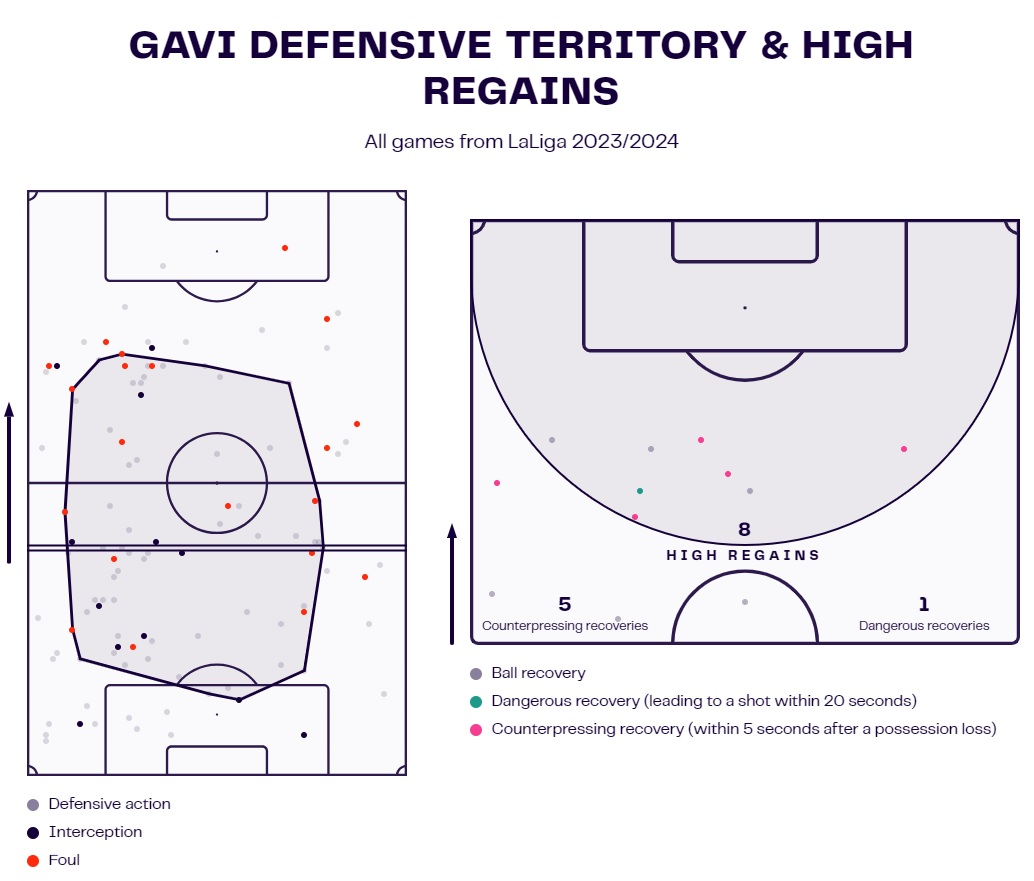
We already know Gavi is the player with the most duels per 90 in the squad but he is also the player with the most successful defensive actions per 90 with 12.67, most defensive duels per 90 (12.47, 60% success) and third-most possession-adjusted interceptions (7.5 per 90). Quite clearly, there is certain off-the-ball value here that's simply critical to Barcelona's style of play.
But pressing and defending is not simply about running a lot. In fact, it's all about running as little as possible while still remaining efficient. Xavi has already alluded to this when he spoke about Gavi.
"Gavi is a very dynamic player but struggles to maintain his position. He can run and press three players in a row and sometimes we have to stop him."
This matters a lot. Knowing when to press and how to press is more important than running riot in the opposition's half. Once Gavi learns this and becomes more positionally disciplined, on and off the ball, he will unlock a new level.
Judging by the improvement we've seen so far, however, he is well on his way to stardom.


